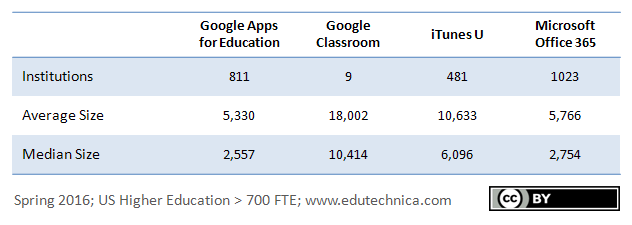Inc. featured an interesting article recently titled Apple, Microsoft, Amazon and Google Are Fighting a War for Your Living Room. It’s not only the living room that these companies are after, but the classroom as well.
In recent months we’ve seen Apple release an iPad app for the classroom after making improvements to iTunes U to give it LMS-like capabilities, Microsoft introduce LMS capabilities into Office 365 Education, Google committing resources to provide APIs for Google Classroom that support assignment workflow and grading, and Amazon announcing a platform to allow instructors to share open educational resources.
It is encouraging to see these mainstream technology companies offering solutions for education, and we’d like to share some data on the number of institutions using certain products from Apple, Google, and Microsoft.
Despite privacy concerns, slightly more than half of institutions with greater than 700 FTE students have become agreeable in recent years to using Google’s and Microsoft’s online productivity software, particularly as e-mail services have been outsourced to the cloud. Over 375 institutions, though, appear to use a separate e-mail service for faculty and staff, perhaps as a way to address privacy or intellectual property concerns. A couple dozen universities offer both Google Apps for Education and Microsoft Office 365 Education accounts. Some institutions are actively migrating between these two solutions.
Google Classroom appears to have experienced minimal uptake. We only counted 9 institutions who actively promote the service for use at an institution-wide level, though there are pockets of individual instructors who have shared links to individual online classrooms. Perhaps this indicates greater grassroots adoption of this technology, as opposed to institutionally-driven. It is also encouraging to see iTunes U used by almost 500 institutions. Curiously, 78% of those institutions who actively use Google Classroom at scale also use iTunes U – compared to just 14.8% of the general population set – perhaps validating that certain institutions exhibit profiles that are more supportive of innovative technology practices.
The best part of our findings, however, is that while these companies may be warring in the living room, they are thriving in the classroom, and this is a trend that we hope continues.
